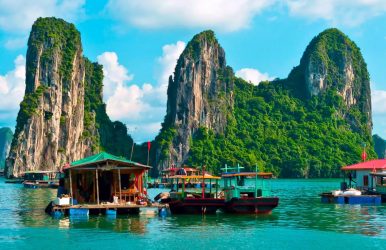Is Barbados Safe? Why Do People Question The Safety In Barbados?
BY Abdul Aziz Dec 21, 2023
If you're interested in obtaining a Bajan visa and taking a vacation there, this post is ideal for you. Barbados is one of the Caribbean's most stunning islands. It boasts the most beautiful scenery, amazing natural beauty, and a very real culture. You'll be shocked to learn about the numerous fascinating facts about Barbados. This island, which seems like heaven, is one of the most popular tourist destinations. Before taking a vacation to another country, everyone does some research on things like safety, Instagrammable locations to visit, the country's climate, etc. Before visiting Barbados, do a little research to help you plan your trip and get the answers to common questions like where is Barbados, is Barbados safe for travel, and when is the best time to travel there. Is Barbados Safe For Travel? One of the most crucial considerations before visiting any country is safety. Barbados is no different. So, is visiting Barbados a safe option? Although Barbados is a safe travel destination, you should exercise caution and refrain from doing certain things to avoid getting into trouble. Not only is it applicable to Barbados, but you should always be aware of crucial safety precautions before visiting any nation. You can feel safe knowing that Barbados is not a dangerous place for tourists, according to the US State Department. There are certain things you need to exercise caution with. For example, you should not stroll alone on dimly lit streets or beaches. Certain parts of Bridgetown, the capital city of Barbados, like Baxter's Road and Nelson Street, should be avoided at all costs. It makes sense to visit popular tourist destinations, and Barbados offers a wide variety of secure lodging options. Traveling to Barbados is safe, the answer to that question is clear-cut. Is Barbados Safe To Travel For Families? Barbados is a fantastic destination for a family vacation. There is a great deal of family-friendly lodging available all over the island, with all those resorts, villas, condos, and mid-range hotels. Barbados is a family-friendly destination, even though it's not always the cheapest place to travel, particularly if you have kids with you. But people do ask, is Barbados safe? It's crucial to remember that not all lodging is designed with kids in mind. Some resorts and hotels. The majority of the island's beaches are suitable for play on beach days. Not all, though, are secure for swimming. Swim only in areas where lifeguards are present. Children and inexperienced swimmers should avoid the east coast due to the strong offshore currents. When traveling to Barbados with kids, the island's natural environment can be a little frightening. First of all, mosquitoes can be more than just a nuisance—they can also pose a threat to kids. Protect yourself and your loved ones from mosquito bites by wearing protective clothing and applying repellent. Things To Do In Barbados One thing you will regret not trying is Oistins' Friday Fish Fry. This is the best place to go in Barbados if you want to see the island's nightlife and eat some mouthwatering fried fish. Visit the Barbados Wildlife Reserve if you're interested in the island's wildlife and animals. There, you can see iguanas, parrots, turtles, snakes, and famous green monkeys, among many other amazing creatures. In general, there are many stunning locations in Barbados that you ought to see. To ensure you see the majority of the attractions and locations on your vacation, try to compile a list of them before you leave. One of the more surprising facts about Barbados may be that it is the birthplace of the alcoholic beverage rum. The Bajans have been making rum for more than 350 years. It's among the world's best and strongest rums. One of the best rum tours in Barbados might be an interesting thing for you to do if you're wondering what to do there. For instance, the oldest operating rum distillery is Mount Gay Rum Centre. Production at this distillery commenced in 1703. You can sample some of the best rum in the world and witness the rum-making process in action at the center. Around the island, there are a lot of vibrant rum shops. You can always go up there and shoot the locals. Best Time To Visit Barbados It's possible that you're wondering when is the ideal time to visit Barbados. Barbados boasts a fantastic climate that is especially enjoyable for visitors. All year long, the weather is pleasant and sunny but not oppressively hot. This is the ideal weather for sunbathing on the beaches and swimming in the ocean. It gets a little chilly at night. On the island, there is also rain, though it usually falls in the form of showers. This is very typical of Barbados, which you are probably aware of. So when would be the ideal time to visit Barbados? Traveling to Barbados is most enjoyable in the months of December through April. The term "dry season" refers to this period of reduced precipitation. In addition, the weather is nicer because it's not as hot as it is in other months. Remember, though, that going to Barbados is best done whenever you feel like it. Night Life In Barbados See the incredible nightlife of Barbados if you enjoy going out to clubs and pubs and generally taking in the nightlife. You can see amazing dinner shows, take a cruise, visit nightclubs, and do a lot of other interesting things. The majority of Barbados' nightclubs are found in St. Lawrence Gap. They provide live entertainment both on the weekends and during the week. One of the best places to visit in Barbados if you enjoy calypso and reggae and are looking for something fun to do while there is no doubt about it. Drug Laws In Barbados It's crucial to familiarize yourself with Barbados' drug laws before visiting. Barbados' laid-back and laid-back culture may lead you to believe that drug use is acceptable there, but that is untrue. On the island, cannabis use for recreational purposes is still illegal. Nonetheless, a sizable population consumes cannabis, which comes from St. Vincent and Jamaica. The law permits registered Rastafarians to use cannabis for both medicinal and spiritual purposes. Bajan Culture British and West African elements heavily influence Barbados' culture. When you visit Barbados, you can observe these influences in the language, architecture, food, and many other areas. One of the key areas where the British influence is most obvious is architecture. From 1625 until 1966, Barbados was a colony of Great Britain. For this reason, British influence is evident, particularly in its culture. Perhaps the most colorful times to visit Barbados are during the island's festivals. Numerous museums, art galleries, exhibitions, and libraries can be found in Barbados' capital city of Bridgetown. Barbados' national sport is cricket, which the islanders take very seriously. If you're interested in visiting Barbados, you should learn more about its history and culture. Bajan Cuisine One of the most exciting things to experience while visiting other nations is food. We recommend that you try all the dishes that you may have never tried before. Barbados' native cuisine, known as Bajan cuisine, is influenced by a variety of cultures, including African, Portuguese, British, Irish, and others. Meals that are typically made with meat and fish and seasoned with various regional herbs and spices are very common. Barbados' two main dishes are cou-cou and fried flying fish. Try those two things without a doubt if you're wondering what to do in Barbados. Is Barbados Safe But Expensive? Barbados is not too expensive to visit. However, a lot relies on your personal preferences. Either select opulent accommodations, vehicles, and dining establishments or select more affordable lodging options and less expensive dining establishments. There are steps you can take to make your trip to Barbados more affordable if you're on a tight budget. Prior to the start of your vacation, you can purchase your airline tickets quite early. Barbados offers a wide variety of affordable, high-quality dining establishments. In particular, Oistins Fish Market is a well-known and reasonably priced restaurant serving fried fish. Rather than taking a taxi, you can go anywhere using a bus. Barbados offers a good public transportation system. You will save money by using it instead of a taxi. Wrapping Up Ultimately, it is crucial to travel only after thorough research. Make sure you are interacting with other online travelers, looking for suitable lodging and people with whom you can socialize. Is Barbados safe? Barbados is safe as long as you know how to tread the path as a visitor. If you have thoughts to share or questions to ask, please leave a comment below. We would love to hear from you! Read Also: Is Cabo San Lucas Safe? – Let’s Find Out! Is Costa Rica Safe For Visit For Travelling? Island Paradise Unveiled: Best Time To Visit The Philippines














